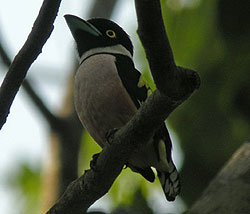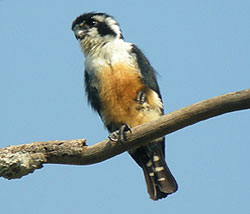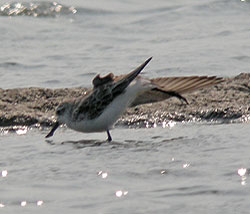
|
||||||||||
|
||||||||||
|
||||||||||
| Favorite Tweets by @thaibirding | ||||||||||
|
||||||||||
| Site Map ; Contributors |
| Laem Pak Bia/Pak Thale & Kaeng Krachan, 19-20th February 2008 | |||||||||||||
|
|||||||||||||
| Tweet | |||||||||||||
| Introduction Michael and Mandy Buckland had a few days for birdwatching close to Bangkok so they decided to join me for a day at Laem Pak Bia/Pak Thale to look for shorebirds and a day at Kaeng Krachan to give them a taste of forest birding in Thailand before they headed to the south. I arranged a vehicle from Q cars for the trip and collected them from the Banyan Tree Hotel in Sathorn Road, Bangkok, at 5 am so that we could be at Laem Pak Bia shortly after it got light and well before the heat became strong. |
|||||||||||||
|
|||||||||||||
| Field
Guides 1. A Field Guide to the Birds of Thailand by Craig Robson 2. Raptors of the World by James Ferguson-Lees & David Christie 3. Pipits and Wagtails of Europe, Asia and North America by Per Alstrom, Krister Mild & Bill Zetterstrom 4. Gulls of Europe, Asia and North America by Klaus Malling Olsen & Hans Larsson 5. A Guide to the Large Mammals of Thailand by John Parr |
|||||||||||||
| Birding
Highlights Laem Pak Bia/Pak Thale: Spoon-billed Sandpiper, Malaysian Plover, Nordmann's Greenshank, Black-faced Spoonbill, Little Stint, White-faced Plover, Greater Painted Snipe, Slaty-breasted Rail, Indian Nightjar Kaeng Krachan: Silver-breasted Broadbill, Banded Broadbill, Black-and-yellow Broadbill, Tickell's Brown Hornbill, Orange-breasted Trogon, Great Slaty Woodpecker, Black-thighed Falconet |
|||||||||||||
| Daily
log 19th February : Picked Mike and Mandy up from the Banyan Tree Hotel and we headed towards Laem Pak Bia. Strangely for the time of the year there was rain on the way but, luckily for us, this stopped very shortly after our arrival at about 7am. The first notable birds after the rain was a large flock of Great Knots and Black-tailed Godwits which also contained a few Red Knot. At this spot we also found many of the more common shorebirds including Red-necked Stint and Long-toed Stint, both on Mike's wanted list. With both Nordmann's Greenshank and Spoon-billed Sandpiper a priority we quickly moved on and stopped by an old salt barn to scan the salt pans. A huge flock of distant waders promised much, particularly with a very pale and far away Greenshank beckoning! True enough, when we got closer, amongst the large group of Great Knots were a few Nordmann's Greenshank. Whilst being very flighty, the birds kept returning to the same spot and eventually we counted a total of 12 Nordmann's Greenshank. After taking our time to study this scarce species we moved on to the regular spot for Spoon-billed Sandpiper. Worth mentioning is how slippery the mud here is after rain. Getting to the parking spot marked on John's map is okay, but trying to drive along any of the other tracks is treacherous, even with a 4-wheel drive vehicle as the tyre treads get full of mud. With a little help we found our first Spoon-billed Sandpiper quite quickly and spending time studying the bird revealed 1, 2, 3, 5, 6 more! Delighted with this sighting we stayed in the area some time, also finding a Dunlin with its black breast half formed, 5 Red-necked Pharalopes and a group of Curlews which was brought to our attention by another birder. Despite the very long bills these Curlews possessed, this is not a reliable identification point for the much hoped-for Far Eastern Curlew. Instead the pale bellies and underwings gave these birds away as the more common Eurasian Curlew. |
|||||||||||||
|
|||||||||||||
| Another good bird which is always easy to find here is Malaysian Plover and we duly found a few pairs of this species to admire too. A large group of birds was resting on the sand spit with Greater and Lesser Sand Plovers present, Sanderling, Kentish Plover, Grey Plover, Red Knot and Greenshank as well as a handsome Chinese Egret | |||||||||||||
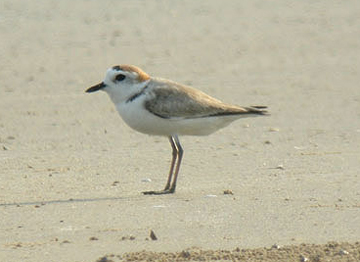 "White-faced Plover" (Photo by Michael Buckland) |
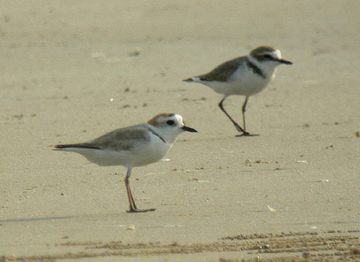 "White-faced Plover" (Photo by Michael Buckland) |
||||||||||||
| Although
we were having a very nice time here, it was time to go back as we
wished to re-enter the King's project before 6pm so we could wait
and watch roosting birds and the emergent bats. A tip here: in the eveing mosquitos at the King's Project are a real problem so wear long trousers and sleeves if possible - if not, then use insect repellent. Waiting for dusk we saw a group of 60-70 White-shouldered Starlings and large numbers of Common and White-vented Mynas. However, a real spectacle was provided by around 1000 Black Drongos that sped into the roosting area in groups of 50 or so, in a stream of birds that lasted around 45 minutes. Just as the Drongos had finished so groups of Black-crowned Night Herons came out to hunt and these are easily seen in the air and on the ground hunting fish. After the Night Herons we then turned our attention to the groups of Fruit Bats coming out of the mangroves and against a full moon they create a memorable sight. As if they were acts ina play, the next species of interest after the bat spectacle was over was to spotlight a Nightjar. It took all of a few seconds to find an Indian Nightjar on the dirt road and then 4 more hunting insects over grass filter beds. This little excursion proved most entertaining and a final sweep of the spotlight revealed a male Greater Painted Snipe probing in the mud. This superb sight was our signal to leave as we had to fit in a delicious beachside dinner and then drive all the way to our accommodation at Kaeng Krachan. 20th February: With such a successful day behind us ("possibly the best day's birdwatching ever" Mike said) it was difficult to expect similar with just one day to spend at Kaeng Krachan. Forest birding is far more unpredictable than wetland birding and can sometimes be quite frustrating. Although there are some great species at the higher points of the mountain, we decided that with only one day it was better to concentrate on the lower levels and to drive quickly in to the moister forest at Ban Krang campsite. We set off at 5.30 am and found it hard to drive past what was obviously good birding on the access road. In the end a group of Thick-billed Pigeons tempted us to stop and having stopped the birds came out in force. First of all Lesser Necklaced Laughingthrush crossed the road, then some Black-naped Orioles put on a show, followed by Asian Fairy Bluebird, Greater Racket-tailed Drongo and other common forest birds. Tempted to move on Mike heard some rummaging around in the undergrowth which proved to be a pair of Large Scimitar Babblers. As if to stop us from moving a couple of Red Junglefowl came out and we also had good looks at Green-eared and Blue-eared Barbets. Keen to get to the campsite we pushed on but there are so many nice birds along the entry road that we stopped again for Golden-crested Myna, again for Hill Myna and Grey-headed Woodpecker, again for Dollarbird which lead us onto a pair of Black-thighed Falconets. So many birds! Eventually we did reach the campsite but were forced to continue on foot as we had missed the 7.30am cut-off for driving uphill. |
|||||||||||||
|
|||||||||||||
| At
1pm the road opens again and we drove past the first and second
streams to do some birding along the road. Once again things went
well with a good view of Orange-breasted Trogon on a side trail
and the briefest of listens to a calling Blue Pitta. Afternoons
in the forest are always slow so we were prepared to see very little
but with patience and persistence one can add the species slowly.
In this way we got Crimson Sunbird, Yellow-vented Flowerpecker,
Ochraceous Bulbul and Asian Paradise Flycatcher. We also heard the
sound of hornbills and got a glimpse at 2 Brown Hornbills. At the
nest site, which is in a large tree to the right hand side of the
dirt track, between streams two and three, Mike got a good view
of the Tickell's Brown Hornbill. Time was beginning to run down now but we got lucky with a fruiting tree where we saw Lesser & Greater Yellownapes, Laced Woodpecker, Greater & Common Flamebacks, Chestnut-breasted Malkoha, Lesser & Greater Necklaced Laughingthrushes, Green Magpie and another Orange-breasted Trogon. Although it was difficult to tear ourselves away from this tree, time was pressing now and we had been told to get out of the park before dark due to elephants causing a danger. However, the calling of 3 Blue Pittas at the second stream made us stop and although it came within 20 metres of us we couldn't see more than a few flashes of movement. We were to be denied the perfect end to a great 2 days but it still gave us some excitement. Dropping Mandy and Mike off in Bangkok they were very happy to have seen a good number of quality species in just 2 days. |
|||||||||||||
|
|||||||||||||
| Nick Upton (nickupton@thaibirding.com) | |||||||||||||
| Species list with sites and notes | |||||||||||||
| Laem
Pak Bia: LPB Pak Thale: PT Mangroves & Sand Spit: MSS |
King's
Project: KP Kaeng Krachan: KK |
||||||||||||
| 1.
Red Junglefowl: A few small groups
at KK. 2. Little Grebe: 1 at King's Project. 3. Lesser Yellownape: 1, KK. 4. Greater Yellownape: 1, KK. 5. Laced Woodpecker: 1, KK. 6. Grey-headed Woodpecker: 2, KK. 7. Common Flameback: 1, KK. 8. Greater Flameback: 3, KK. 9. Great Slaty Woodpecker: 1 briefly between streams 1 & 2, near Ban Krang campsite, KK. 10. Green-eared Barbet: fairly numerous at KK. 11. Blue-eared Barbet: 1 seen, many heard, KK. 12. Coppersmith Barbet: 1, KK. 13. Tickell's Brown Hornbill: 2 briefly seen near nest tree, KK. 14. Oriental Pied Hornbill: several seen, KK. 15. Orange-breasted Trogon: 2, KK. 16. Common Kingfisher: 1, KP. 17. White-throated Kingfisher: 1, LPB. 18. Black-capped Kingfisher: Several, PT, LPB, MSS, KP. 19. Collared Kingfisher: Numerous at MSS. 20. Green Bee-eater: 2, LPB. 21. Lesser Coucal: 2 on the drive into KK. 22. Asian Koel: 1 male, KP. 23. Black-bellied Malkoha: 2, KK. 24. Green-billed Malkoha: 2, KK. 25. Chestnut-breasted Malkoha: 1 in a mixed flock, KK. 26. Dollarbirdt: 4, KK. 27. Vernal hanging Parrot: 2, KK . 28. Germain's Swiftlet: 1, LPB. 29. Asian Palm Swift: Everywhere. 30. Brown-backed Needletail: 3, KK. 31. Asian Barred Owlet: 1 seen, KK.. 32. Indian Nightjar: 2 at KK, 5 at KP. 33. Rock Pigeon: LPB, PT, KP. 34. Spotted Dove: KK, PT, KP, LPB. 35. Red-collared Dove: Several, PT, LPB, KP. 36. Thick-billed Green Pigeon: About 25, KK. 37. White-breasted Waterhen: 2, LPB. 38. Slaty-breasted Rail: 1, LPB. 39. Ruddy-breasted Crake: 1 KP. 40. Greater Painted Snipe: 1 male in spotlight, KP. 41. Pintail Snipe: Several, KP. 42. Common Snipe: Several, KP. 43. Black-tailed Godwit: 40 or 50, LPB. 44. Eurasian Curlew: Approximately 20, PT. 45. Spotted Redshank: Plentiful, LPB, PT, KP. 46. Marsh Sandpiper: Many LPB, PT, KP. 47. Common Greenshank: A few, LPB, PT. 48. Nordmann's Greenshank: 12, LPB. 49. Green Sandpiper: 1, KP. 50. Wood Sandpiper: A few, KP. 51. Common Sandpiper: A few, LPB, PT. 52. Ruddy Turnstone: 2, PT. 53. Great Knot: Many, LPB. 54. Red Knot: A few, LPB. 55. Ruff: Approximately 10, KP, LPB. 56. Sanderling: 6, MSS. 57. Spoon-billed Sandpiper: 7, PT. 58. Little Stint: 1, LPB. 59. Red-necked Stint: Many, LPB, PT, KP. 60: Temminck’s Stint: A few, LPB, PT. 61. Long-toed Stint: 10-20, LPB, KP, PT. 62. Dunlin: 2, PT. 63. Curlew Sandpiper: Many, LPB, PT. 64: Broad-billed Sandpiper: Many LPB, PT. 65: Red-necked Pharalope: 5, PT. 66. Black-winged Stilt: Many, LPB, PT, KP. 67. Little Ringed Plover: A few, LPB, PT, KP. 68. Oriental Pratincole: 5, PT. 69. Kentish Plover: Many, LPB, PT, KP, MSS. 70. Malaysian Plover: 4, MSS. 71. "White-faced Plover": 1, MSS. 72. Lesser Sand Plover: Many, KP, PT, LPB, MSS. 73. Greater Sand Plover: A few LPB, MSS. 74. Pacific Golden Plover: 6, LPB, PT. 75. Grey Plover: About 12, LPB, PT. 76. Red-Wattled Lapwing: Several, KP, KK. 77. Heuglin's Gull: 1 adult, MSS. 78. Pallas's Gull: 4, MSS. 79. Brown-headed Gull: Many, LPB, PT, MSS. 80 Caspian Tern: Approximately 25. 81. Lesser Crested Tern: 1 MSS. |
82. Great Crested Tern: 15,
LPB, MSS. 83. Common Tern: Many, LPB, PT, MSS. 84. Gull-billed Tern: About 10, LPB, PT. 85. Little Tern: Many, LPB, PT, MSS. 86. Whiskered Tern: Many, LPB, PT, KP. 87. Black-eared Kite (lineatus Black Kite): 1, LPB. 88. Brahminy Kite: 2, PT, LPB. 89. Osprey: 1, LPB. 90. Black-thighed Falconet: 2 mating, KK. 91. Little Cormorant: Many, LPB, PT, KP. 92. Indian Cormorant: 7, LPB. 93. Black-faced Spoonbill: 2, LPB. 94. Little Egret: Many, LPB, PT, MSS, KP. 95. Chinese Egret: 2, MSS. 96. Great Egret: Many, LPB, PT, MSS, KP. 97. Intermediate Egret: A few, LPB, PT, KP. 98. Grey Heron: About 20, LPB, PT, KP. 99. Chinese Pond Heron: Everywhere. 100. Black-crowned Night Heron: Many, KP. 101. Silver-breasted Broadbill: A flock of about 10, KK. 102. Banded Broadbill: A very noisy pair, KK. 103. Black-and-yellow Broadbill: A pair calling, KK. 104. Blue-winged Leafbird: 1 female, KK. 105. Asian Fairy Bluebird: A few, KK. 106. Brown Shrike: 3, LPB, KP. 107. Black Drongo: LPB, PT and probably over 1000 entering a roost at KP. 108. Ashy Drongo: 3 or 4 mouhoti and leucogenis, KK. 109. Bronzed Drongo: Common, KK. 110. Spangled (Hair-crested) Drongo: 5 or 6, KK. 111. Greater Racket-tailed Drongo: 5 or 6, KK. 112. Green Magpie: 2, KK. 113. Racket-tailed Treepie: 2, KK. 114. Black-naped Oriole: Several, KK. 115. Ashy Minivet: 3, KK. 116. Scarlet Minivet: 3, KK. 117. Pied Fantail: 2, KP. 118. Black-naped Monarch: 1 male, KK. 119. Asian Paradise Flycatcher: 1 indochinensis, KK. 120. Large Woodshrike: 1, KK. 121. Taiga Flycatcher: 2, KK. 122. Grey-headed Canary Flycatcher: 1, KK. 123. Oriental Magpie Robin: A few, LPB, PT, KP. 124. White-rumped Shama: 1m & 1f at Ban Krang campsite, KK. 125. Ashy Woodswallow: 2, LPB and 2, KK. 126. Asian Pied Starling: Many, LPB, PT, KP. 127. White-shouldered Starling: A flock of about 65 at pre roost near KP. 128. Common Myna: Many, LPB, PT, KP. 129. White-vented Myna: Many, LPB, PT, KP. 130. Golden-crested Myna: 4, KK. 131. Hill Myna: 4, KK. 132. Barn Swallow: Everywhere. 133. Red-rumped Swallow: A few, KK. 134. Black-headed Bulbul: 4, KK. 135. Black-crested Bulbul: Many, KK. 136. Stripe-throated Bulbul: 2, KK. 137 Streak-eared Bulbul: A few, LPB. 138. Grey-eyed Bulbul: A few, KK. 139. Ochraceous Bulbul: Many, KK. 140. Golden-bellied Gerygone: 1 seen and many heard, KP. 141. Plain Prinia: 3, LPB. 142. Common Tailorbird: A few, KK. 143. Dusky Warbler: 1, KP. 144. Greenish Warbler: 1, KK. 145. Two-barred Greenish Warbler: 1, KK. 146. Eastern Crowned Warbler: 1, KK. 147. Greater Necklaced Laughingthrush: 1, KK. 148 Lesser-necklaced Laughingthrush: Several groups, KK. 149. Large Scimitar Babbler: 2, KK. 150. Striped Tit Babbler: Many, KK. 151. Rufous-fronted Babbler: 2 in a mixed flock, KK. 152. Yellow-vented Flowerpecker: 1, KK. 153. Ruby-cheeked Sunbird: 1m, KK. 154. Olive-backed Sunbird: 2, KK, KP. 155. Crimson Sunbird: 1, KK. 156. Paddyfield Pipit: 1, LPB. 157. Yellow Wagtail: 1, KP. 158. Grey Wagtail: 1, KK. 159. Eurasian Tree Sparrow: Many, LPB, PT, KP. 160. Plain-backed Sparrow: A pair, KP. |
||||||||||||
| Nick Upton can be contacted at nickupton@thaibirding.com | |||||||||||||
| Click
for more information on Laem
Pak Bia/Pak Thale |
Click for more information on Kaeng Krachan | ||||||||||||
| If you are interested in arranging a bird watching tour you can see some suggested itineraries here - Birdwatching Trips - and you can contact me at the above email address to discuss the best options. | |||||||||||||
 |
|||||||||||||
|
Tweet |
|||||||||||||

A Guide to Birdwatching in Thailand. Copyright © 2004-2015 thaibirding.com. All rights reserved.


